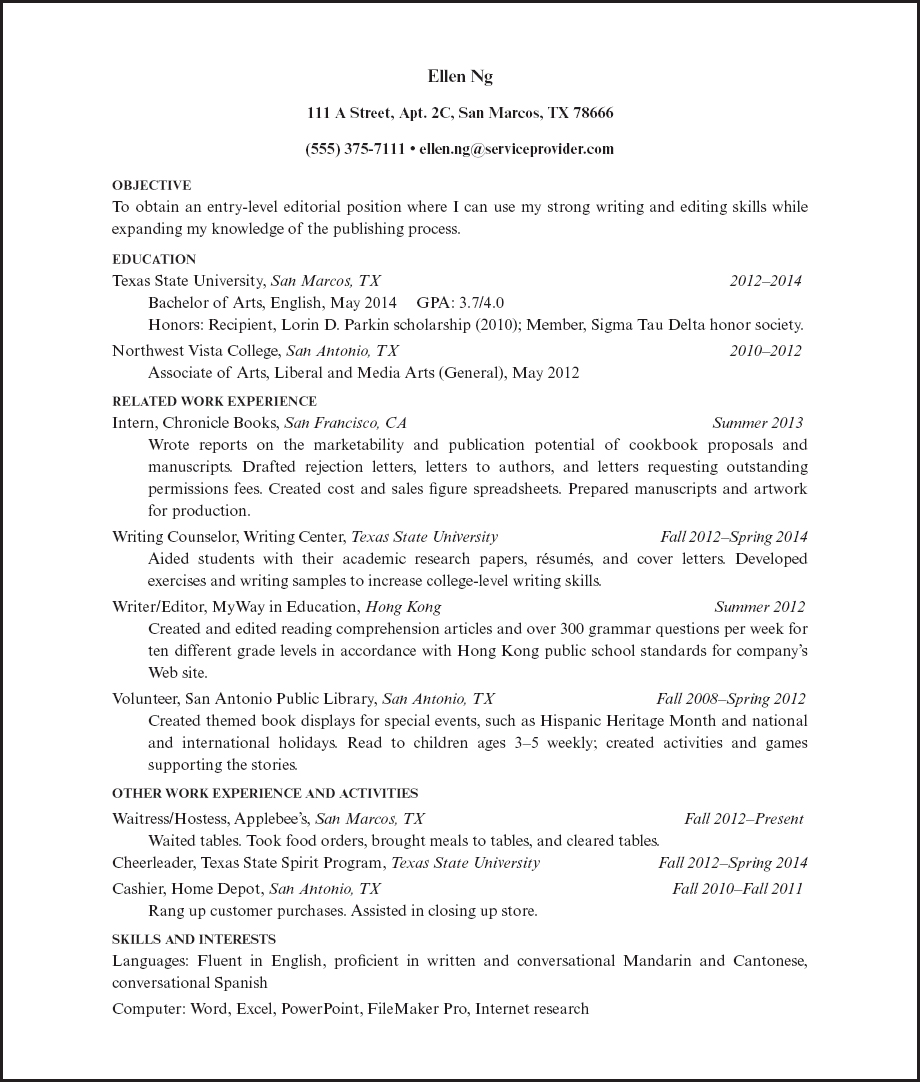Prepare Your Materials
Preparing for a job interview is similar to preparing for a speech. In Chapter 12, we suggest studying your audience to know how to present information they’ll find useful and interesting; in a job interview, you must do the same. Your goal is to learn about the organization’s culture (Chapter 11): Is it a formal or informal place? What does the organization value? This information helps you adapt your communication competently and impress a hiring manager.
Once you’ve identified potential jobs, you’ll need to make contact with the people in a position to hire you. As a job applicant, the crucial first impression you make on a potential employer will likely be via your written materials—
But first, a cautionary note: before you send off these written materials, make sure you have cleaned up any searchable information that does not portray you in a favorable light (Brandenburg, 2008; Holson, 2010). If you use social networking sites, adjust your privacy settings to ensure that you have not been, and cannot be, tagged in any photographs that you wouldn’t want a potential employer to see and that the details of your profile are not visible to anyone other than your approved friends. Perform searches for your name and e-
The résumé. Begin by pulling together a résumé—a printed summary of your education, work experiences, and accomplishments (see Figure A.2). It is a vehicle for making a positive first impression on potential employers. An effective résumé tells just enough about you to make employers believe they may need your skills and experience.

No two résumés look exactly alike, but most résumés should contain the following general information:
- Contact information. Include both campus and home addresses if necessary, phone numbers, and your e-
mail address. Make sure that your voice mail greets callers with a clear, professional message, and check it often. If you have an odd or cute address for your regular e- mail (partygirl@provider.com, numberonedad@provider.net), consider opening another account with a more serious name for all of your professional communication. - Employment objective. Be concise and specific about what you’re looking for in a position and your career goals. If you are applying for several types of jobs, you should create multiple résumés tailored to specific positions.
- Education. List the institutions you have attended, their locations, and the dates of attendance. List degrees received (or dates to be received), academic majors, and areas of concentration. Awards and GPA can be listed if they enhance your marketability.
- Work experience. If your work experiences are all in the same area, list them in reverse chronological order (most recent ones first), focusing on concrete examples of achievement or skills that you have mastered. Explain job functions as well as titles. If, on the other hand, you have had a variety of jobs (for example, waiting tables and being a camp counselor), reverse chronological order may not be very practical. Consider grouping actual employment and volunteer activities together in a way that best matches the job responsibilities you are seeking. Remember that prospective employers read this section carefully to discover how your experience, abilities, and achievements relate to their organization’s needs. You can make this easier for them with a clear and organized presentation of yourself.
- Activities. For employers, participation in a variety of academic, extracurricular, or social activities indicates that you are motivated and get involved. Include activities that are relevant to your career objective, emphasizing accomplishments and leadership roles—
and link them clearly together. - Special skills. Do you speak fluent Spanish? Are you skilled in a particular programming language? Have you managed a charity race in your community? Don’t be shy—
let potential employers know this information. Your skills may be useful to the organization, and your accomplishments show dedication and determination. - References. Your references are typically professors, previous supervisors, or anyone else who can confirm your employment history and attest to your work ethic and character. Some organizations want you to include your references (with current contact information) with your résumé, and others will ask for those once you get your first interview (Joyce, 2008). Be sure to include only people who have agreed to serve as references for you.
Once your résumé is complete, take some time to prepare it for electronic submission. Make sure it is readable on all platforms by saving it as a pdf document, so that employers can read it regardless of what type of computer they have. You should also name the file carefully, so that employers will be able to identify it easily. Include your name (or just your last name) in the file title, along with the word résumé and perhaps a date (for example, MartinezRésumé Jan2015.pdf).
The cover letter. Whenever you send your résumé to a potential employer, it should be accompanied by a formal cover letter (see Figure A.3), a one-

In many cases, prospective employers accept e-